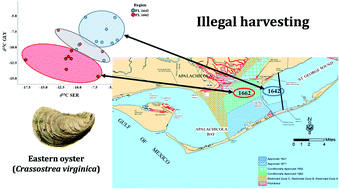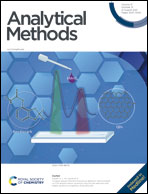Origin determination of the Eastern oyster (Crassostrea virginica) using a combination of whole-body compound-specific isotope analysis and heavy metal analysis†
Abstract
Various samples of the Eastern oyster, Crassostrea virginica, were collected from five harvest bay areas in the Gulf of Mexico coastal waters of Florida (FL), Louisiana (LA) and Texas (TX). Cadmium and lead concentrations from the extracted whole-body soft tissues were analyzed by inductively coupled plasma-mass spectrometry (ICP-MS), and bulk δ13C and δ15N isotope ratios and amino-acid-specific δ13C values were analyzed via isotope ratio mass-spectrometry (IRMS). The combined data was subjected to multivariate statistical analysis to assess whether oysters could be linked to their harvest area. Results indicate that discriminant analysis using the δ13C values of five amino acids—serine, glycine, valine, lysine and phenylalanine—could discriminate oysters from two adjacent harvesting in Florida with 90% success rate, using leave-one-out cross validation. The combination of trace elements and isotope ratios could also predict geographic provenance of oysters with a success rate superior to the isolated use of each technique. The combinatory approach proposed in this study is a proof-of-concept that compound specific stable isotope analysis is a potential tool for oyster fisheries managers, wildlife, and food safety enforcement officers, as well as to forensics and ecology research areas, although significantly more work would need to be completed to fully validate the approach and achieve more reliable statistical results.



 Please wait while we load your content...
Please wait while we load your content...